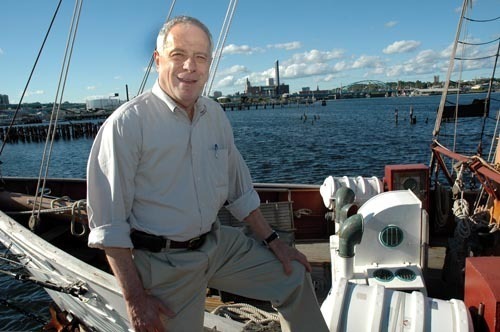
For decades, Newport’s waterfront has been trending away from industrial uses. Thirty years ago, much of it was used for boatbuilding, shipping and maintenance. Today, however, it’s mostly housing, restaurants and recreation, according to Newport County Chamber of Commerce (NCCC) President Keith Stokes.
“In Newport today, the Newport shipyard is really a megayacht marina,” Stokes said. “It provides ship services but it really can’t provide the large-scale overhaul work [like] the hull painting and sandblasting work; the winter storage.”
So the new policy on Aquidneck Island is to acquire U.S. Navy land as it’s released by the federal government and to redevelop it for maritime businesses, Stokes said. The R.I. Economic Development Corporation and the Newport County Chamber are in final negotiations and are undertaking environmental-impact studies on a 42-acre parcel in Portsmouth, he said.
Developing the land is going to require some private investment, Stokes said, by a consortium of boat builders that has already agreed to acquire the property.
“That’s going to happen by the end of the year,” Stokes said.
Such public-private cooperation will be crucial to the effort to expand the nation’s maritime transportation system, according to a recently released federal report.
In the next 20 years, greater public-private cooperation will be needed to plan, run and reestablish waterfronts and transportation systems, whether they are industrial or not, according to the “National Strategy for the Marine Transportation System,” a 61-page report issued in July by the U.S. Committee on the Maritime Transportation System.
That study – an evaluation of port systems and waterfront issues around the country – said that 43.5 percent by value and 77.6 percent by weight of all U.S. international trade comes through the country’s water-based transportation system. That value is expected to increase to as high as 67 percent by 2020.
The study recommends that federal funds being allocated for waterfront projects are awarded in a prioritized way – with the project’s potential impact to the local community being the first priority.
In Providence, on the Allens Avenue corridor, members of the Providence Working Waterfront Alliance are pretty clear on how they view those priorities. The group earlier this year issued a report that said seven of the water-dependent businesses along the industrial corridor pay about $5 million in annual taxes and employ 372 workers.
Standing out near the end of the dock at Promet Marine Services on a recent late summer day, Vice President Joel H. Cohen pointed to a semi-abandoned property sitting a few hundred yards south. The privately owned site includes two brick buildings on 6.5 acres that’s mostly vacant, Cohen said.
It could become a prime spot to draw economic development in Rhode Island, he said. With an investment of about $30 million, a new pier and industrial business could be added, he said. Such an investment would require municipal support, he said.
“Anything on the waterfront requires a partnership with the federal government, but it [also] requires direction on the part of the state and the municipality,” Cohen said. “And it requires private enterprise to pull the whole thing together.”
For that reason, the Waterfront Alliance is critical of the City of Providence’s planners, who have proposed a different approach, including rezoning much of the waterfront to allow for mixed-use facilities and maybe some residential. A follow-up meeting to the Charrettes – a weeklong public meeting where those changes were discussed in June – was scheduled for Wednesday, Sept. 24.
Promet President David A. Cohen said his company is working on infrastructure at its own property. It has started an engineering study for the reconstruction of State Pier No. 1, which is now a jumble of broken wood and piles. Promet will need to apply for a U.S. Maritime Administration grant to rebuild the 400-foot dock, he said.
In line with the city’s growing interest in adding new zoning to Providence’s waterfront, the CMTS study predicts that all uses – commercial, recreations, scientific research and others – along the county’s waterfronts will increase during the coming years. But it stops short of offering a clear solution, aside from better communication between the parties. “The interaction of these uses is also expected to increase,” it says. “As a result, to promote safety and reduce risks to life, property and marine life, intergovernmental collaboration and action to address these interactions will be required.”
The Cohens last week were working to repair damages to the hull of a Block Island ferry that was in an accident. Without their shipyard, the Connecticut-based vessel would have had to travel to Maine or New York to be fixed.
“Waterfront land is so scarce and so valuable,” Joel H. Cohen said. “This is where the government is setting its sights to work with private and state initiatives. But the initiative on the state has not been, I’m sad to say, too strong. And the initiative on the part of the city has been weak.”
Stokes’ Chamber is a supporter of the Waterfront Alliance. He said the way Providence handles waterfront zoning could have regional impacts, affecting the economy and local business.
“What we’re really trying to articulate is there needs to be ongoing support for working waterfronts across Narragansett Bay,” said Stokes, who also serves on the boards of both RIEDC and the Quonset Development Corporation.
In Portsmouth, where 42 acres are set to be “protected” waterfront industry in perpetuity, Stokes made it clear that supporting the maritime transportation industry with services will be increasingly important to Rhode Island in the future.
“By the very fact that more people are living on the waterfront, it has changed not only the use, but also the value” of that land, Stokes said. So it’s become either “unaffordable or near to impossible” to run a true working waterfront.
“If we didn’t [decide to rezone that land], we would loose this very vital [maritime] industry,” Stokes said. “What I think is the last true manufacturing industry in the state.” •










